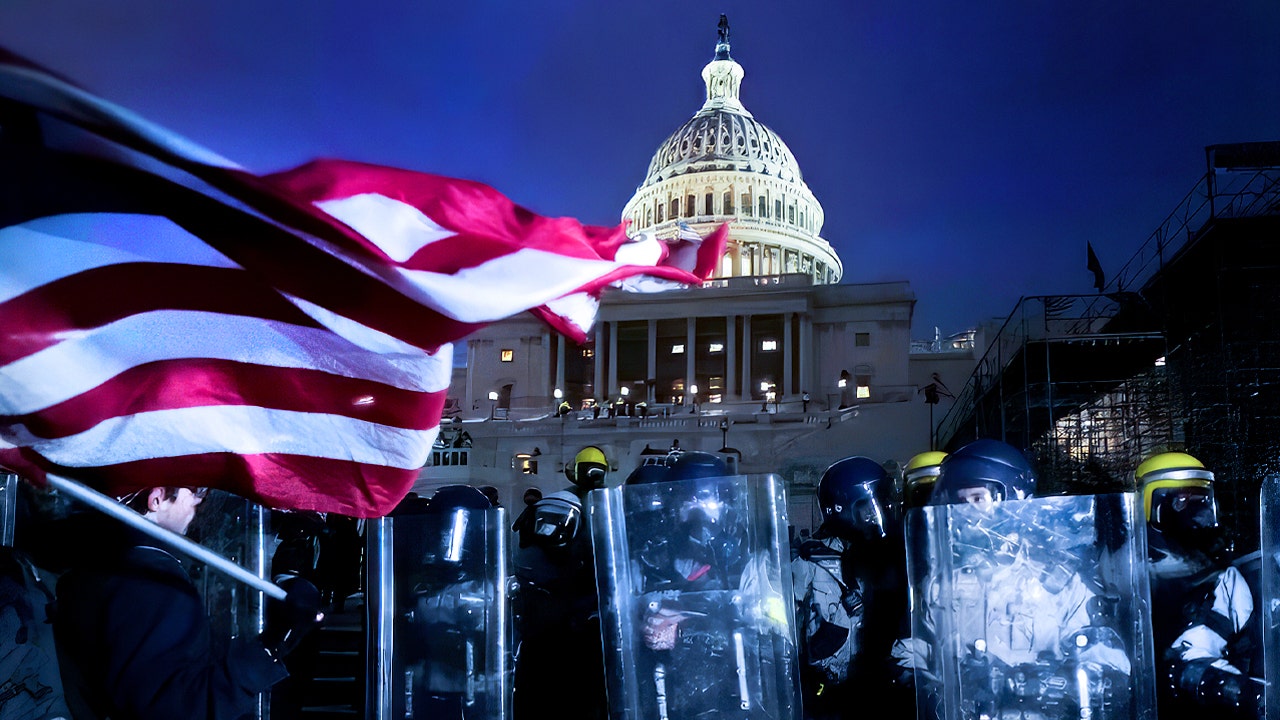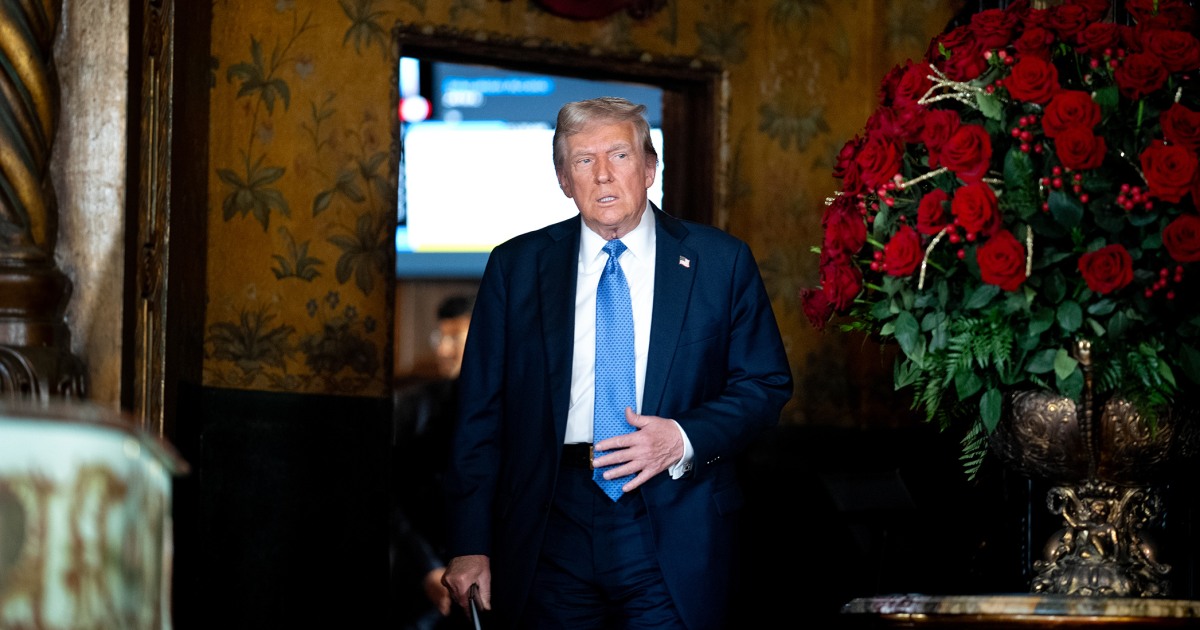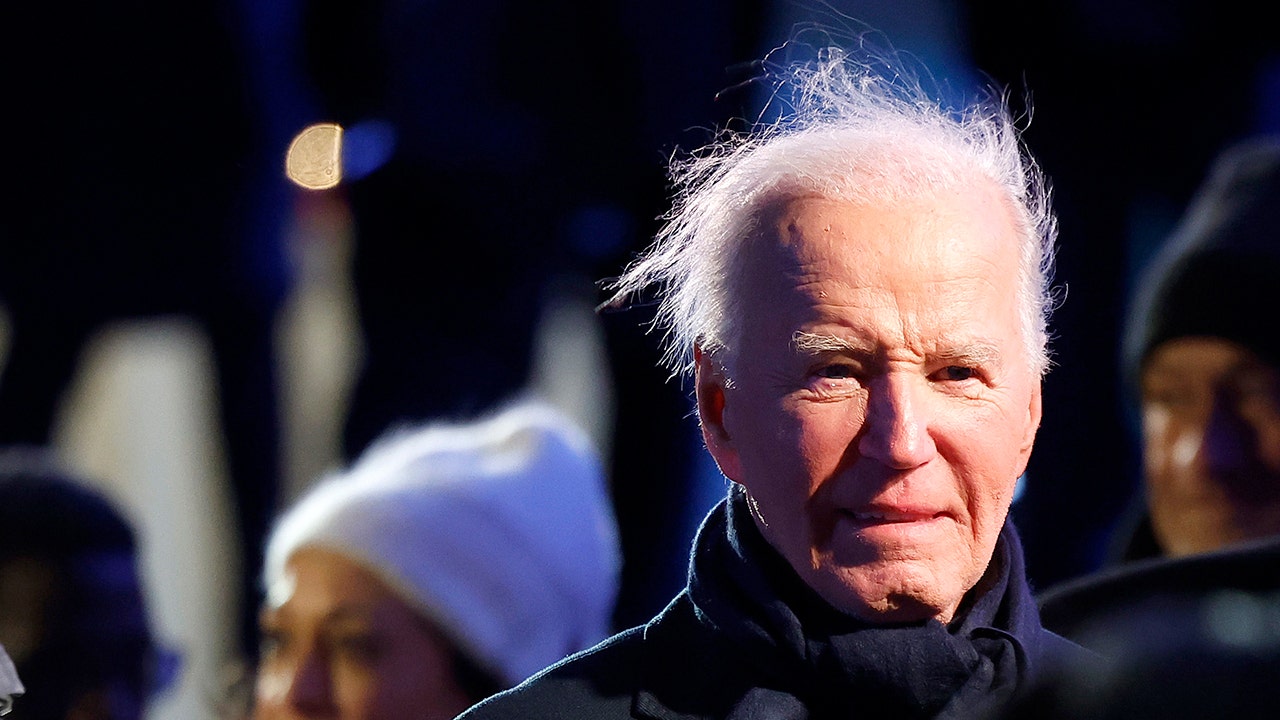Sports
Lake McRee's connection with Miller Moss fueling USC's new-look offense
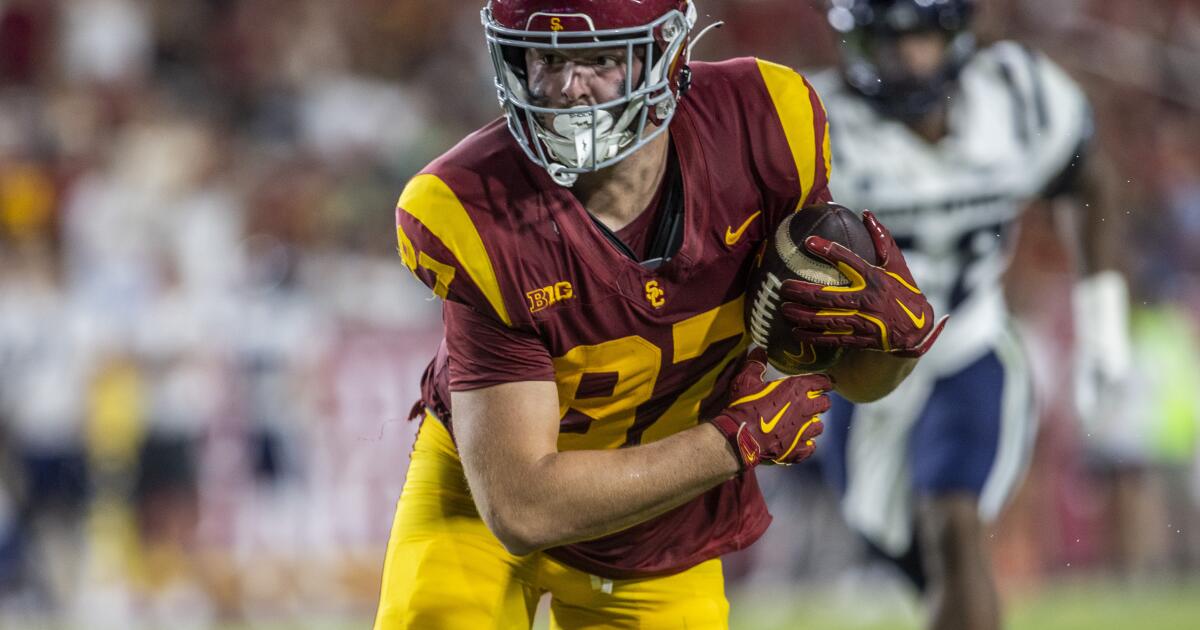
When Lake McRee felt a pop in his right knee during bowl practice last December, the USC tight end didn’t think much of it at first. He finished the play, then lined up for another. Even ran a route. McRee may have kept going still, if a coach had not pulled him aside and told him something looked strange in his stride.
The diagnosis, McRee said, was “devastating.” A torn anterior cruciate ligament, his second in just over four years.
The timing was especially cruel. Not only would he miss the Holiday Bowl, which was shaping up to be a breakout moment. Considering when the tear occurred, it wasn’t clear, at the time, if McRee would be back for the start of USC’s 2024 campaign.
Beyond that, it was a major blow to the trajectory of the Trojans’ tight end room. Any hope that the position would suddenly play a major role in USC’s offense this season seemed to be put to rest with the injury.
But eight months later, McRee was miraculously back to full speed. And two games into this season, his fourth at USC, no pass catcher has had a bigger impact on the Trojans’ offense than the redshirt junior tight end, who leads the team in both receptions (nine) and receiving yards (137) and ranks eighth in the nation in both categories among tight ends.
“Having Lake back fully healthy has been awesome,” quarterback Miller Moss said. “I have a lot of faith and trust in him, and I think he’s delivered in a way that I expected and the offense expected him to.”
USC tight end Lake McRee warms up before a win over LSU at Allegiant Stadium in Las Vegas on Sept. 1.
(Robert Gauthier/Los Angeles Times)
The expectation, since Lincoln Riley arrived at USC, had been that tight ends would eventually occupy a bigger role in the Trojans offense, like they had in Oklahoma. But that potential had yet to come to fruition at the position. Tight ends accounted for 3% of USC’s passing offense in 2022, then just 5% in 2023, as Caleb Williams relied far more on buying time and hitting his speedy receivers down the field.
That identity appears to be shifting significantly with Moss at quarterback. Moss has gotten rid of the ball a full second faster on average than Williams, while more frequently working the middle of the field on short and intermediate routes, where a sure-handed, big-bodied pass catcher can especially come in handy.
The redshirt quarterback has already targeted tight ends 15 times through two games, nearly halfway to the total targets tight ends saw last season.
Knowing Moss as well as he does, McRee expected that might be the case this season. The thought was in the back of his head as he went through rehabilitation treatment multiple times per day during the spring and summer, pushing his way through a recovery process that he said could be “demoralizing.”
“If I got back in time for the season, I knew me and Miller had a good connection,” McRee said. “He likes a lot of tight end stuff in the offense.”
Moss, who considers McRee a close friend, smiled at the suggestion. “I don’t know who told Lake that,” he joked.
But against Utah State, those preferences proved to be a critical part of Riley’s game plan, as USC worked far more with 12 personnel, which uses two tight ends, than usual. As a result, McRee played 10 more snaps than any other position player on USC’s offense, while young tight ends Kade Eldridge (34) and Walker Lyons (18) did their part and saw three targets each.
Others, like talented freshmen Joey Olsen or Walter Matthews, could work their way into the tight end rotation before the season is done.
“It’s a deeper room, probably a more talented room than we’ve had in the first couple years,” Riley said.
That’s a testament to McRee, who returned from serious injury to step into his biggest role yet at USC.
“It really speaks to who he is as a person and a player,” Moss said. “He’s a tough … kid — and a really good player.”

Sports
Eli Manning and the Hall of Fame argument that may never go away

Two guys are sitting in a bar.
They could be talking about who the Giants’ next quarterback should be, or what went wrong with Daniel Jones. Instead, they are talking about Eli Manning, as, it seems, they have been for most of the last two decades. They are debating whether he should be voted into the Pro Football Hall of Fame when he becomes eligible for the first time this year.
Pro-Eli guy: “He beat Tom Brady twice in the Super Bowl.”
Anti-Eli guy: “Yeah, but he was a .500 quarterback in the regular season. His record was 117-117. Does that sound like a Hall of Famer?”
Pro-Eli guy: “Only six players in the history of the NFL have two Super Bowl MVP trophies, and he’s one of them.”
Anti-Eli guy (smirking): “Ha! He never was even voted All-Pro!”
Pro-Eli guy (slams beer mug on the bar): “Did you know, including playoff games, he had 42 game-winning drives and that he was 10-4 in overtime games?”
Anti-Eli guy (voice rising now): “He threw 244 interceptions. That’s more than any player since 2004. And he led the NFL in interceptions three times.”
The argument will go on for a while. It could be hours, days, months or lifetimes. It’s possible no NFL player has ever engendered a wider spectrum of emotions from his team’s fans.
Eli has heard it all.
If he turns on the television, he will hear more. On social media, the debate rages. But where he stands, there is none of that noise — just two Super Bowl trophies, two Super Bowl MVP trophies and a contentment about what has been and what will be.
For Eli Manning fans, these four trophies are the only evidence they need that he should be in the Hall of Fame. (Dan Pompei / The Athletic)
In the spring of 2004, Eli was the most highly regarded prospect in the draft after leading Mississippi to its first 10-win season in 32 years. The San Diego Chargers had the first pick, and Eli had misgivings about an organization that failed to make the playoffs the previous eight years, struck out with Ryan Leaf and was struggling to develop Drew Brees.
He was intentionally unimpressive in meetings with the team, and when the Chargers appeared undeterred about selecting him, he made it clear he wished they wouldn’t.
“It was not comfortable for me,” Eli says. “But I felt strongly that I didn’t want to go there. I never tried to dictate that I go to the Giants, though.”
The Chargers picked him, made him wear their cap for one of the most awkward draft photos in history, and then traded him to the Giants, which was his hope. Eli was careful about what he wished for, if not completely aware of the consequences.
“I didn’t realize,” he says, “what I was getting into.”
In his first days as a Giant, Eli was met with skepticism and resentment — and that was just from his teammates. Some were not pleased that the team had cut the popular Kerry Collins for a rookie.
“We were like, ‘Who is this spoiled brat — Archie Manning’s son, Peyton’s little brother — making a big stink about what team he wants to play for,’” Giants center Shaun O’Hara says. “What kind of guy is this?”
Eli failed to beat out Kurt Warner for the starting job but made his way into the lineup in late November. By then he was suffering from comparisons to Peyton, who was named the NFL’s most valuable player that year, and Ben Roethlisberger, the quarterback chosen 10 picks after him by the Steelers who was on his way to a Super Bowl victory.
In his first start, Eli was booed.
In his fourth loss without a win, his quarterback rating was 0.0, and he was pulled from the game. On the train home from Baltimore to New Jersey, he sat with quarterbacks coach Kevin Gilbride and told him he had no excuses. But he noted many of the plays the Giants were using were plays Warner favored. Eli gave Gilbride eight plays that he wished the Giants would use. They started using them and his career trajectory changed.
The next season he led the Giants to an NFC East title. But that didn’t win over New York, whose sportswriters came after him like German Shepherds after an intruder and whose customers seemed to enjoy jeering his misthrows more than celebrating his excellence.
Giants defensive end Michael Strahan thought Eli had more pressure on him than any player in the league, given the environment, his last name and the draft history.
“People don’t understand how tough it is to play in New York City,” Strahan says. “It’s another level of scrutiny. I admire him because emotionally, I could not have handled what he handled from the media and fans at times.”

GO DEEPER
Voice memos, legendary cameos help ‘ManningCast’ redefine NFL broadcast
Eli ignored what the media said about him but made it a point to know what was being said about his teammates so he could be a locker room fireman.
The boos, he admits, were upsetting. But he took them in stride. “I think in most cases I probably deserved it,” he says.
Year 4 was tumultuous, starting with criticism from recently retired running back Tiki Barber about Eli’s leadership. Four of his league-leading 20 interceptions that season came in a 41-17 home loss to the Vikings, and three of them were returned for touchdowns.
He was booed by his own many times but never as lustily as on that day. Peyton went to one of his games every year. That was the game.
“It was tough on all of us,” Archie says. “But he didn’t go to his room afterward and sulk and pout. He said he would bounce back the next week.”
Eli owns those interceptions — and all the others.
“Sometimes, I knew what the read was and where the ball should be going and I didn’t want to run because I wasn’t great at scrambling,” he says. “So I probably forced the ball too many times and put the ball in harm’s way.”
Whenever a play didn’t work, for whatever reason, Eli raised his hand. “My fault,” he said over and over. He met with the media on Mondays only after losses. When the Giants won, he wanted the attention on others.
After the loss to the Vikings, the Giants won three of the next four games and earned a wild-card spot in the playoffs.
On the road, they beat the Bucs and Cowboys before taking on Brett Favre and the Packers in Green Bay where temperatures reached minus-5 with a minus-27 wind chill. The Giants’ 23-20 victory earned them the right to be lambs for the wolves from New England in Super Bowl XLII. The Patriots were 18-0 and 12-point favorites.
With 2:42 remaining, the Patriots led 14-10. That’s when Strahan gathered his teammates on the sideline and gave an impassioned speech. “17-14 is the final, OK?” he said. “17-14, fellas. One touchdown and we are world champions.”
Strahan looked in many of his teammates’ eyes. In some, he saw determination. In some, he saw uncertainty. And then there was Eli.
“He had the same strange Eli look as usual, kind of confused but yet confident,” Strahan says. “It was just the weirdest, strangest look that he had on his face at times, but that’s just Eli. He never seemed overwhelmed.”
The Giants faced a third-and-5 on their 44 with 1:15 left to play. Eli dropped back and somehow got away from three pass rushers who could have sacked him, then threw up what seemed like an ill-advised pass in the middle of the field. David Tyree made the impossible “helmet catch” over Rodney Harrison, giving the Giants a first down on the Patriots’ 24.
Where does the David Tyree catch rank in your all-time Super Bowl plays? 👀
📺: #SBLVIII – Feb. 11 6:30pm ET on CBS
📱: Stream on #NFLPlus pic.twitter.com/yDEBYJ8VoP— NFL (@NFL) February 3, 2024
Four plays later, Eli connected with Plaxico Burress on a 13-yard touchdown pass that made the Giants Super Bowl champions.
When Eli and Strahan embraced on the field afterward, Strahan remembers a different look on his teammate’s face.
“He was so exhausted,” Strahan says. “It was as if he had all the years of holding these emotions in and he could finally breathe.”
Eli’s expressions could be difficult to read. Gilbride, his position coach for three years and offensive coordinator for seven, initially wondered how much Eli cared based on the faces he made.
“His competitiveness is not readily discernable,” says Gilbride, who now does research for Eli and Peyton’s “ManningCast.” “He never looks like he gets angry. But his desire is as good as I’ve ever seen. It’s a high-intensity fire in him.”
Gilbride felt the fire when he apologetically called Eli at 10 p.m. on many Wednesdays to go over unusual defensive looks they could face that week. No problem, Eli always told him. He was watching tape anyway. And besides, Eli had already considered the problem and potential solutions.
The fire was evident again on Fridays when some players were looking forward to enjoying an afternoon off. Not so fast, Eli would tell them. He had prepared teaching tapes for each position group and expected every player to review the tapes with him.
Giants guard Chris Snee, who was part of the same draft class as Eli, sat next to him on airplane trips and always shared a Bud Light on the team bus after games, says Eli worked harder than anyone in the organization.
“I prided myself on being one of the first guys in, but Eli was always there, too,” Snee says. “And then, to his credit, he was always there when I was leaving.”
Four seasons after Eli led the Giants to his first Super Bowl win, the NFL locked out players in the offseason because of a collective bargaining divide. Eli saw it as a potential advantage.
For the first time in his career, he stayed in New Jersey for the entire offseason. He scheduled team workouts at high schools and scripted practices for the offense and defense.
“We had the opportunity to outwork people, and that’s not always the case in the NFL,” Eli says. “I probably worked the hardest I ever worked that offseason.”
That season, the Giants went 9-7, but it was an ugly 9-7. They allowed more points than they scored, had the NFL’s 32nd-ranked running game, the 27th-ranked defense and an overwhelmed offensive line. But Eli led eight game-winning drives and passed for a career-high 4,933 yards as wide receiver Victor Cruz — Eli’s special offseason project — broke out with a career year.
“We were spoiled”
Victor Cruz & Mario Manningham on Eli’s greatness
Watch 𝑨𝒍𝒍 𝑰𝒏 𝑵𝒀𝑮 Ep. 5: https://t.co/EHgo320Sq6 pic.twitter.com/Y1wjJACA6d
— New York Giants (@Giants) September 25, 2021
In the playoffs, Eli won again at Lambeau Field, this time by outdueling Aaron Rodgers. Then came the NFC Championship Game at the 49ers, which some consider Eli’s most remarkable performance. He was sacked six times and threw 58 passes in a 20-17 victory that tested the limits of human endurance.
“He got physically assaulted all game,” says Snee, who apologized to Manning for his performance on the bus afterward. “We were peeling him off the ground numerous times and he was never rattled or started yelling.”
Eli never missed a game because of injury, not in junior high school, high school, college, or the NFL. He played through a separated shoulder in 2007 and plantar fasciitis in 2009, and his streak of 210 straight starts is the 10th-longest in league history.
With 3:46 to play in Super Bowl XLVI, the underdog Giants trailed the Patriots by two points. Eli began a possession on the Giants’ 12 with a perfect pass, perhaps the most perfect in the history of Super Bowls. Mario Manningham ran a sideline route and Eli placed the ball where only Manningham could catch it before stepping out of bounds. The 38-yard completion was the spark to the game-winning drive.
On a recent “ManningCast” NBC analyst Cris Collinsworth said he never saw a better throw.
It was one of Eli’s four most impressive games, along with Super Bowl XLII and the conference championship games that preceded both Super Bowls.
“Every major opportunity he had, he took advantage of,” Strahan says. “He’s just a closer, man.”
In high school, his friends called him “Easy” or “Easy E.” The nickname, appropriate as any ever, stuck.
Eli cannot recall a time in a football game when he felt nervous. In those fight-or-flight moments in which heroes are discovered, Eli’s palms never moistened, his heart never raced and his eyes never darted side to side.
“When those Super Bowls were on the line, I had zero negative thoughts,” he says. “I’m only thinking about scoring a touchdown and winning a Super Bowl.”
After the Super Bowl, the Giants failed to do what was necessary to protect their quarterback and began an organizational struggle that continues to this day. For the rest of his career, Eli had a 48-67 record as a starter. He played in just one more playoff game.
In late November of 2017, the Giants were 2-9. Eli was watching tape on a Tuesday by himself in the quarterbacks room as always when coach Ben McAdoo came in and told him his plan was for Eli to start the next game that week, but Geno Smith would replace him during the game.
Eli suspected McAdoo was starting him just to keep his streak of consecutive starts alive. He and his wife, Abby, cried it out that night. The next morning, he went in early and asked McAdoo if the streak was the reason he was starting. McAdoo confirmed it was.
“That’s not what this is about,” Eli told him. “You don’t play someone because of a streak. How can you coach that way? How can I prepare that way? Let’s pull the Band-Aid off now.’”
The streak ended. Eli started four more games that season and 16 the next before becoming a backup to Jones in 2019, his last season in the NFL.

GO DEEPER
Duggan: An appreciation of Eli Manning in his final days as a Giant
Texas quarterback Arch Manning, the son of Eli’s brother Cooper, recently texted his uncle Eli. He wanted to talk about what to do when he’s out with friends and fans ask to take photos.
Eli told Arch that when he was playing, someone once asked to take a picture. Eli obliged, and the photo of him holding a beer and making a funny face made the rounds. Everyone had a laugh at “drunk Eli.” From then on, whenever he was at a restaurant or bar, he told fans that he had to follow a team rule that prohibited him from taking pictures where alcohol was served.
Eli had concocted the team rule and suggested Arch take the same approach.
As the quarterback in the city of overreactions, Eli was determined to be understated. He rejected repeated invitations to appear on “Saturday Night Live” until after winning his second Super Bowl and turned down multiple endorsement opportunities.
“I was always very conscious of how the media would portray me in this market,” he says. “I never wanted people to think I was silly or not focused.”
To O’Hara, Eli understood the responsibility of being the face of the Giants.
“So many quarterbacks have come and gone in the New York market in the last 20 years, but this good old boy from New Orleans somehow figured out Da Vinci’s code,” says O’Hara, who has long considered Eli one of his best friends.
To teammates, Eli revealed himself. One of his secrets was he liked to have a good time — like, a really good time.
“I’ve seen Eli dancing on tables,” Strahan says, chuckling.
Strahan also has been a victim of Eli’s practical jokes. Eli often changed the language on teammates’ mobile phones to Chinese, but he went beyond that with Strahan. The defensive end picked up his mobile phone to see the wallpaper had been changed to a photo of a teammate’s private parts.
Before the Giants left to go to Super Bowl XLII in Arizona, they had a walkthrough in East Rutherford. Players had their dress clothes in their lockers so they could change before heading to the buses. When Eli’s offensive linemen looked for their dress shoes, they couldn’t find them — in their place were new shoes painted bright purple. And so they headed to the Super Bowl looking like clowns as their quarterback cracked up.
In his post-playing days, Eli has gone from concealing his personality to marketing it. For the ESPN show “Eli’s Places,” he wore elaborate makeup as a tryout quarterback named Chad Powers to prank Penn State coaches. On the “ManningCast,” he has done the “Sexy Dexy” dance and sang for Pete Davidson. On “The Eli Manning Show” on Giants.com, he cooked with Matthew McConaughey and had a pie-eating contest with Jason Biggs.
He played so long and hard, but somehow time has been a friend. Many old quarterbacks wear their sacks, interceptions and losses on their faces. Not Eli.

Being home with his family, including son Charlie and daughter Caroline, is a big part of Eli Manning’s post-playing life. (Courtesy of the Manning family)
At 43, he works out several times weekly, taking early morning high-intensity interval training classes at a local gym. He has had only one surgery in his life — an ankle cleanup in 2015. He says nothing hurts enough to mention, and he can run, jump and throw, which he does often when he plays with his four children.
One of the reasons the “ManningCast” appealed to him more than a traditional broadcasting job is he does it from his basement. Eli’s priority is being there for his family, as it was for Archie when the boys were young.
Ava, 13, wants to do it all like Eli did at her age. Her determination is like his, too. She is a competitive swimmer and lacrosse player and also plays field hockey and basketball. Lucy is more laid back. The 11-year-old likes individual sports, especially tennis. Eli has been helping her study states, capitals and fractions. School comes easy for 9-year-old Caroline — his joke is she takes after Mom. She plays hockey.
Charlie, 5, has learned all the NFL teams by their helmets. He can tell you his father played for the Giants, his uncle played for the Colts and Broncos, and his grandfather — “Red,” they call him — played for the Saints, Oilers and Vikings.
Charlie plays hockey, basketball and flag football for two teams — both are the Giants. Eli is a coach on both football teams.
After their first three children were girls, Eli did not yearn for something he didn’t have. But Abby wanted a boy, partly because she dreamt of a son who would treat her as sweetly as Eli treats his mother, Olivia.
Eli and Olivia always had a special connection. It grew during the five years he was the only kid in the house after his brothers went to college.
Olivia collects antiques. Eli accompanied her on search missions and became a collector himself.
“You think Peyton was going to go antique shopping with his mother?” Archie says.
Olivia loves wine. Eli subsequently took an interest in wine, and now it is a shared passion. When his mother visits, he breaks out a special bottle from his cellar.
Eli Manning, author of history, owner of big moments, thrower of interceptions and master of perspective, steps out to his front yard, into the smell of autumn and the beautiful chaos of a young family.
School just got out, and kids are coming and going, laughing and playing. This is a special time of day for Eli.
He looks out to where life has led.
When he was playing, Eli never had his sights set on the Hall of Fame.
“All my goals were about team-oriented success,” he says. “Trying to win championships — that was my goal.”
He isn’t anxious about his chances now, though he acknowledges being inducted would be very meaningful.
“Whether I get in or don’t get in, it’s not going to impact how much I’ve appreciated the game or what I’ve taken from the game or the friendships, the good times, the bad times,” he says. “I feel so grateful to have been with the New York Giants organization for 16 years.”
He could campaign for himself. But he won’t.
“That’s not me,” he says. “And hey, I can see both sides of the case. That’s just kind of my personality.”
And now Charlie wants to toss around a football with his father. Charlie throws it as if he were born to. His passes travel high and deep, arcing like rainbows.
Eli Manning’s legacy? Whatever it is, he’s good with it.
(Top photo: Sarah Stier / Getty Images)
Sports
Chiefs are motivated by doubters who say record is a fluke, star says: 'We'll just keep showing up'
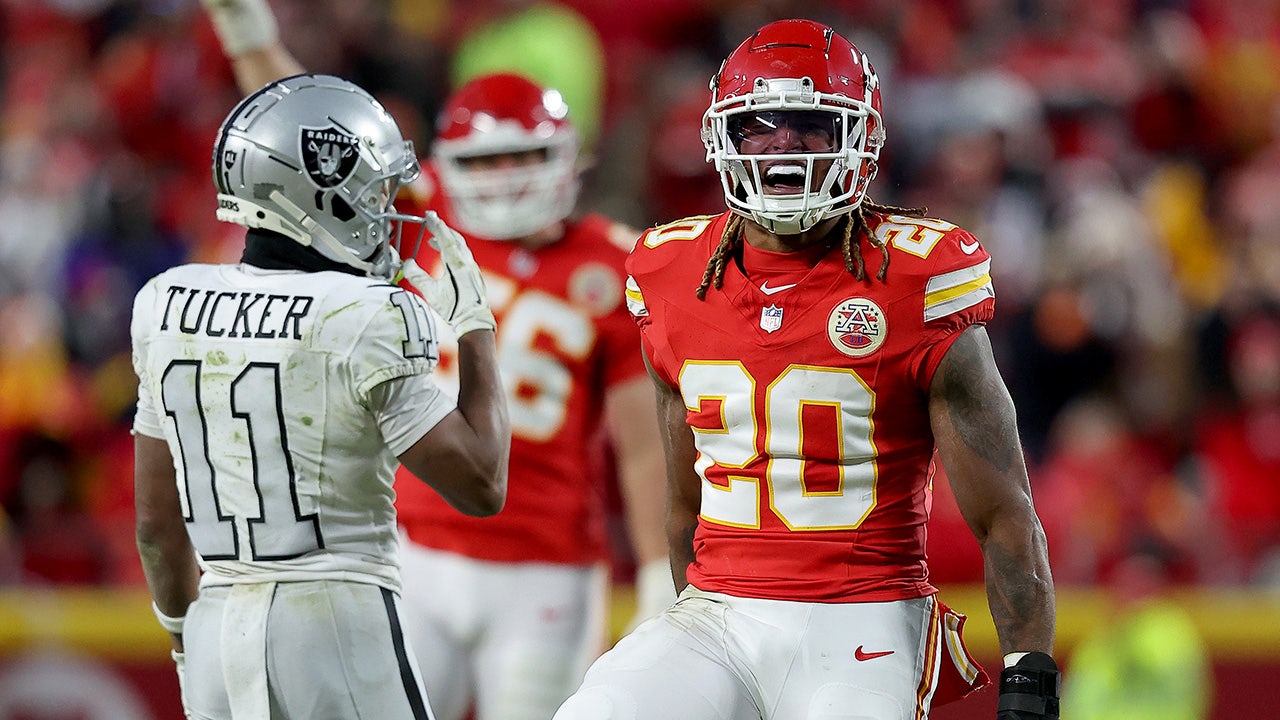
It’s been rather commonplace to say that the 13-1 Kansas City Chiefs should not be what their record is – but that’s just fuel to the fire for the back-to-back champions.
Sure, the Chiefs have won multiple games on their last possession, and the ball has bounced their way plenty of times – literally and figuratively.
But Chiefs safety Justin Reid, quite literally, is thanking those who doubt what the Chiefs can do in the playoffs.
Justin Reid #20 of the Kansas City Chiefs celebrates a defensive stop against the Las Vegas Raiders during the fourth quarter in the game at GEHA Field at Arrowhead Stadium on November 29, 2024 in Kansas City, Missouri. (David Eulitt/Getty Images)
“Thanks for the motivation. We appreciate the motivation that people give us,” Reid told Fox News Digital in a recent interview. “Despite winning two championships in a row, despite everything that they said last year, they still don’t believe. And we appreciate it. That fires us up when we hear it. I like the extra motivation. It gets me fired up, and it gets me to go out there to prove a point.
“They don’t ever have to [learn]. We’ll just keep showing up.”
Reid has won two Super Bowls with the Chiefs, but his ring back in February wasn’t the only championship he won this year. He also took home Chess.com’s BlitzChamps title.
Reid was always intrigued with chess but took it more seriously when he got into the NFL – and now, it’s become somewhat of a staple in the locker room.
“We have a tradition where we play every night before the game. Right when we finish team meetings, I have a chess board sitting at my locker, guys come, and we play quick five-minute games. Guys from the front office come down, players play, and if you win, you stay, you lose, you get back in line,” Reid said.
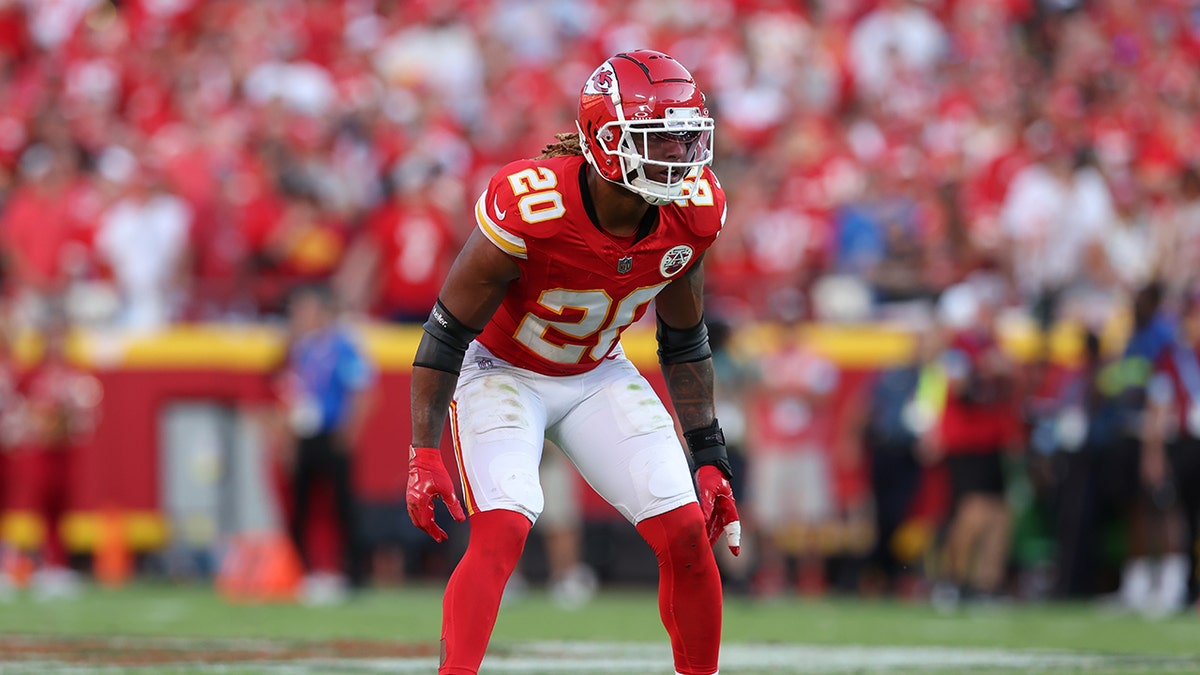
Kansas City Chiefs safety Justin Reid (20) in the fourth quarter of an NFL game between the Cincinnati Bengals and Kansas City Chiefs on September 15, 2024 at GEHA Field at Arrowhead Stadium in Kansas City, MO. (Scott Winters/Icon Sportswire via Getty Images)
‘JEOPARDY!’ CONTESTANTS BEFUDDLED BY FINAL CLUE RIPPING JETS’ SUPER BOWL DROUGHT
The safety added it’s become a combination of both superstition and firing up the brain before a game.
“You can’t always be too deep in anything. It’s nice to get your mind off one subject and do something else. I think it’s fun for that and it has become a bit of a tradition that we just always do that now,” he says.
NFL Films will be releasing a documentary about Reid’s chess title and how other NFL stars have gotten involved. The title also gave Reid the ability to raise money for his own charity.
“Everyone uses the same ‘it’s a game of chess’ whether it’s football or business or whatever’s going on,” Reid said, adding it’s a good way for people to connect. “It’s a way of using tactics and being three steps ahead of your opponent. It’s fun they’re promoting it. I think that it’s good, and I think it’s a fun game for anyone to play.”
Reid faces his former Houston Texans on Saturday afternoon as the Chiefs are in the final homestretch. And considering he’s a back-to-back reigning champ, he knows exactly what it takes to bring home another Lombardi Trophy.
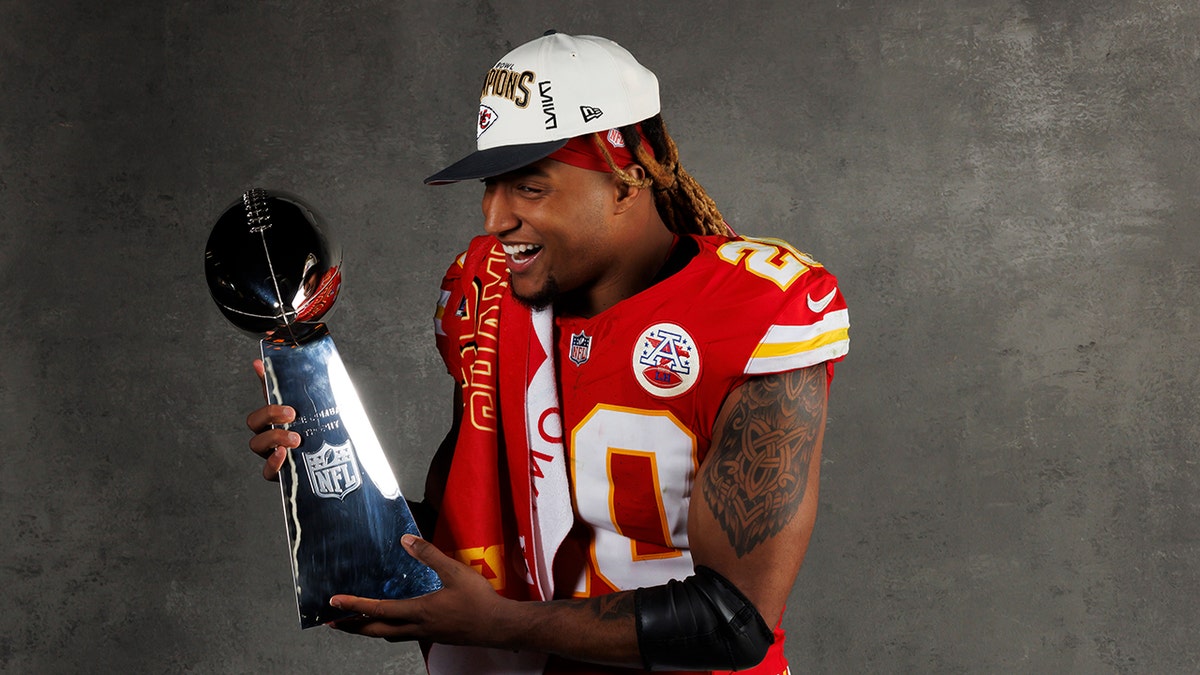
Justin Reid #20 of the Kansas City Chiefs poses for a portrait with the Vince Lombardi Trophy after Super Bowl LVIII against the San Francisco 49ers at Allegiant Stadium on February 11, 2024 in Las Vegas, Nevada. (Ryan Kang/Getty Images)
“You want to be playing your best football going into the playoffs, and we don’t feel like we’ve played our best football yes, which is great,” said Reid. “There’s still ways to build, still things to do to keep getting better. It’s just about not being satisfied and the preparation each week. The physical side will take care of itself, but whoever’s mentally prepared and doesn’t make those mental mistakes when the pressure’s on is going to be the difference. We’ve been here before, we’ll just keep continuing to do it.”
Follow Fox News Digital’s sports coverage on X, and subscribe to the Fox News Sports Huddle newsletter.
Sports
Prep basketball roundup: Sherman Oaks Notre Dame reaches Tarkanian Classic championship game

Sherman Oaks Notre Dame is loving late-night basketball in Las Vegas.
The unbeaten Knights (12-0) advanced to the Platinum Division championship game of the Tarkanian Classic, opening a 20-point lead before prevailing over Layton Christian (Utah) 73-60 on Friday night. Notre Dame will face Eastvale Roosevelt (10-1) for the championship Saturday at 4:30 p.m. at Bishop Gorman. They are ranked No. 2 and No. 4 in The Times’ top 25 rankings.
Tyran Stokes continued his impressive play with a 29-point, 10-rebound performance after a 30-point effort on Thursday. NaVorro Bowman had 20 points.
Eastvale Roosevelt 78, Redondo Union 74: Brayden Burries and Myles Walker each scored 18 points in the win. Roosevelt had a 45-32 halftime lead before handing Redondo Union (9-1) its first defeat. Hudson Mayes had 22 points and Chris Sanders scored 20 points for Redondo Union.
Crespi 76, St. Anthony 56: The Celts (8-4) picked up a quality nonleague win, with Peyton White scoring 26 points, Isaiah Barnes 16, Carter Barnes 14 and Malakai Perrantes 13.
La Habra 70, Sonora 45: The Highlanders are 13-1 after a strong performance from Jaedon Anderson, who made a school-record nine threes en route to a 32-point effort.
Anaheim Canyon 91, Costa Mesa 41: Brandon Benjamin had 31 points for Canyon.
Grant 67, Viewpoint 66: In only its second game of the season, the Lancers (2-0) served notice they figure to reach the City Section Open Division playoffs. Aeneas Grullon scored 26 points for Viewpoint (9-3). Wizdom Burnes, who scored 18 points and had 13 rebounds for Grant, made a shot at the buzzer for the win. Champ Merrill led Grant with 24 points.
Harvard-Westlake 74, Fairfax 33: Joe Sterling had 21 points and Cole Holden 14 points for the Wolverines.
Chatsworth 66, West Albany (Ore.) 56: The Chancellors improved to 7-1 in Oregon. Alijah Arenas had 24 points.
Golden Valley 60, Gardena 45: Alex Villego had 25 points for Golden Valley.
Legacy Christian 78, Crescenta Valley 71: Vaughn Zargarian had 41 points for Crescenta Valley.
Heritage Christian 81, Valencia 40: Tae Simmons had 22 points and Dillan Shaw 19 for 11-0 Heritage Christian.
Palisades 55, El Camino Real 54: Jack Levey made a shot at the buzzer to give Palisades the victory.
Girls basketball
Ontario Christian 73, Maryland Bullis 65: Kaleena Smith had 26 points and nine assists for unbeaten Ontario Christian (14-0), which will play in the Nike TOC final against Archbishop Mitty from San José in a game that will decide No. 1 in California and maybe No. 1 in the nation in girls basketball. Archbishop Mitty defeated Mater Dei 59-42 in the other semifinal.
Sierra Canyon 69, Coeur d’Alene (Idaho) 56: Jerzy Robinson led the unbeaten Trailblazers with 30 points.
Birmingham 65, Mt. Diablo 50: Lili Martinez had 20 points and Zoee Mitchell 16 for the Patriots.
St. Joseph 85, Valencia 84: Freshman Kamilia Basyrova scored a school-record 40 points for Valencia.
-

 Politics1 week ago
Politics1 week agoCanadian premier threatens to cut off energy imports to US if Trump imposes tariff on country
-
/cdn.vox-cdn.com/uploads/chorus_asset/file/25782636/247422_ChatGPT_anniversary_CVirginia.jpg)
/cdn.vox-cdn.com/uploads/chorus_asset/file/25782636/247422_ChatGPT_anniversary_CVirginia.jpg) Technology1 week ago
Technology1 week agoInside the launch — and future — of ChatGPT
-
/cdn.vox-cdn.com/uploads/chorus_asset/file/25789444/1258459915.jpg)
/cdn.vox-cdn.com/uploads/chorus_asset/file/25789444/1258459915.jpg) Technology1 week ago
Technology1 week agoOpenAI cofounder Ilya Sutskever says the way AI is built is about to change
-

 Politics1 week ago
Politics1 week agoU.S. Supreme Court will decide if oil industry may sue to block California's zero-emissions goal
-
/cdn.vox-cdn.com/uploads/chorus_asset/file/25546252/STK169_Mark_Zuckerburg_CVIRGINIA_D.jpg)
/cdn.vox-cdn.com/uploads/chorus_asset/file/25546252/STK169_Mark_Zuckerburg_CVIRGINIA_D.jpg) Technology1 week ago
Technology1 week agoMeta asks the US government to block OpenAI’s switch to a for-profit
-

 Politics1 week ago
Politics1 week agoConservative group debuts major ad buy in key senators' states as 'soft appeal' for Hegseth, Gabbard, Patel
-

 Business6 days ago
Business6 days agoFreddie Freeman's World Series walk-off grand slam baseball sells at auction for $1.56 million
-
/cdn.vox-cdn.com/uploads/chorus_asset/file/23951353/STK043_VRG_Illo_N_Barclay_3_Meta.jpg)
/cdn.vox-cdn.com/uploads/chorus_asset/file/23951353/STK043_VRG_Illo_N_Barclay_3_Meta.jpg) Technology6 days ago
Technology6 days agoMeta’s Instagram boss: who posted something matters more in the AI age











